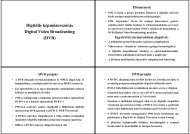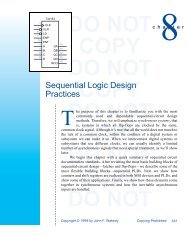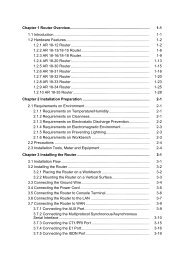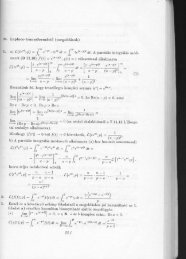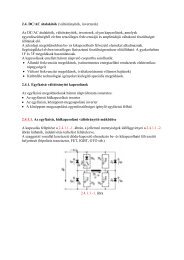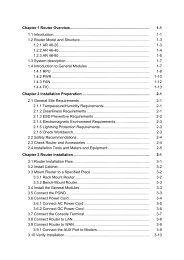Quidway AR 28 Series Routers Installation Manual.pdf - Index of
Quidway AR 28 Series Routers Installation Manual.pdf - Index of
Quidway AR 28 Series Routers Installation Manual.pdf - Index of
- No tags were found...
You also want an ePaper? Increase the reach of your titles
YUMPU automatically turns print PDFs into web optimized ePapers that Google loves.
<strong>Installation</strong> <strong>Manual</strong><strong>Quidway</strong> <strong>AR</strong> <strong>28</strong> <strong>Series</strong> <strong>Routers</strong>Chapter 5 Startup and Configuration <strong>of</strong> the RouterII. System decompression and initializationThe screen will display:Now system is self-decompressing...System now is starting...Press ENTER to get startedPress and the screen will display:[<strong>Quidway</strong>]This prompt indicates that the router has entered the system view, and now the routercan be configured.5.2 Configuration Fundamentals <strong>of</strong> the Router5.2.1 Basic Configuration StepsIn general, the configuration steps are as follows:Step 1: Before configuring the router, the networking requirements should be madespecific, which include networking purpose, the role <strong>of</strong> the router in the network, thedivision <strong>of</strong> subnets, WAN type and transmission medium, the network security policyand reliability.Step 2: Based on the above requirements, draw a clear and integrated networkingdiagram.Step 3: Configure the WAN interface <strong>of</strong> the router. First, configure the physicaloperating parameters (e.g., the operating mode <strong>of</strong> the serial interface, baud rate andsynchronous clock) <strong>of</strong> the interface according to the transmission medium <strong>of</strong> the WAN.For the dial-up interface, the user also needs to configure DCC parameters. Then,configure the link layer protocol encapsulated on the interface and the related operatingparameters according to the WAN type.Step 4: Configure the IP addresses or IPX network numbers <strong>of</strong> all the interfaces on therouter according to the division <strong>of</strong> the subnets.Step 5: Configure the routes. If it is necessary to enable a dynamic routing protocol, theuser should configure the related operating parameters <strong>of</strong> the protocol.Step 6: If special security is required, perform the security configuration for the router.Step 7: If special reliability is required, perform the reliability configuration for the router.5-6




